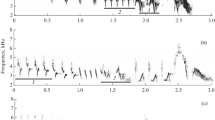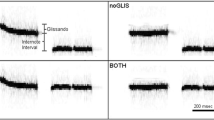Summary
-
1.
Sound emissions of the species Sehirus biguttatus (L.), Canthophorus melanopterus H. S. and C. dubius (Scop.) were detected, oscillographically and sonagraphically analysed and compared with the song pattern of the already investigated species Tritomegas bicolor (L.).
-
2.
Males and females of all four species emit disturbance sounds that although in no way species specific, are typical to a certain degree for different sexes (M-1, W-1; Fig. 1).
-
3.
In males of all four species two courtship songs (M-2, M-3) and one rival song (M-R) can be distinguished. All of them are species specific (Fig. 2, 4).
-
4.
The rival song of Canthophorus melanopterus is nearly fully identical with courtship song I. These songs are quite similar in Tritomegas bicolor, but are clearly different in Sehirus biguttatus and Canthophorus dubius.
-
5.
The agreement song of the female (W-2) is species specific also, but the differences among the male courtship songs are greater. The females ready for copulation regularly emit an answer to the first male's courtship song (M-2). An exception is the species Canthophorus melanopterus, where quite often an alternating song consisting of the courtship song II (M-3) and the agreement song (W-2) was observed (Fig. 5).
-
6.
Among the species of Cydnidae which were compared the differences observed for the corresponding courtship songs were in amplitude modulation and in frequency spectra (Fig. 3).
-
7.
There are similar sound patterns in the courtship songs of different species, but ethologically they are not of the same meaning.
-
8.
The greatest differences found were those for the male courtship and rival songs of both closely related sympatric Canthophorurus species.
-
9.
In all species copulation followed only after an alternating song of the mating partners. The females respond with an agreemant song only to the courtship song of males of the same species.
-
10.
The experiments reported here support earlier conclusions that species specific sound emissions in Cydnidae are barriers to cross mating.
Zusammenfassung
-
1.
Die Lautäußerungen der Arten Sehirus biguttatus (L.), Canthophorus melanopterus H. S. und C. dubius (Scop.) wurden registriert, oszillographisch und sonagraphisch analysiert und mit den Gesangmustern der Art Tritomegas bicolor (L.) verglichen.
-
2.
Männchen und Weibchen aller vier Arten äußern Störungslaute, die nicht artspezifisch, in gewissem Maße aber geschlechtstypisch sind (M-1, W-1; Abb. 1).
-
3.
Bei Männchen aller vier Arten kann man zwei Werbegesänge (M-2, M-3) und einen Rivalengesang unterscheiden (M-R), die alle artspezifisch sind (Abb. 2, 4).
-
4.
Der Rivalengesang ist bei Canthophorus melanopterus mit dem Werbegesang I fast völlig identisch. Bei Tritomegas bicolor sind diese Gesänge ähnlich, bei Sehirus biguttatus und Canthophorus dubius jedoch deutlich verschieden.
-
5.
Die Einwilligungsgesänge der Weibchen (W-2) sind artspezifisch; die Unterschiede bei den männlichen Balzgesängen sind größer. Paarungsbereite Weibchen antworten grundsätzlich auf den ersten Werbegesang (M-2) des Männchens. Eine Ausnahme bildet die Art Canthophorus melanopterus, wo öfters auch ein Wechselgesang zwischen Werbegesang II (M-3) und Einwilligungsgesang (W-2) beobachtet wird (Abb. 5).
-
6.
Die Balzgesänge der verglichenen Cydnidenarten unterscheiden sich in der Amplitudenmodulation und in den Frequenzspektren (Abb. 3).
-
7.
In den Balzgesängen verschiedener Arten kommen ähnliche Lautäußerungsmuster vor, die verschiedene ethologische Bedeutungen haben.
-
8.
Am meisten unterscheiden sich die männlichen Werbe- und Rivalengesänge der beiden nächst verwandten sympatrischen Canthophorus-Arten.
-
9.
Zur Paarung kam es bei allen Arten erst nach einem Wechselgesang der Geschlechtspartner. Die Weibchen antworten mit dem Einwilligungsgesang nur auf die Werbungsgesänge arteigener Männchen.
-
10.
Frühere Deutungen artspezifischer Lautäußerungen bei Cydniden als Kreuzungsschranke scheinen berechtigt zu sein.
Similar content being viewed by others
Literatur
Busnel, R. G.: Acoustic behaviour of animals. Amsterdam-London-New York: Elsevier 1963.
Gogala, M.: Die akustische Kommunikation bei der Wanze Tritomegas bicolor (L.) (Heteroptera, Cydnidae). Z. vergl. Physiol. 63, 379–391 (1969).
Haskell, P. T.: Stridulation and its analysis in certain Geocorisae (Hemiptera, Heteroptera). Proc. zool. Soc. Lond. 129, 351–358 (1957).
Jordan, K. H. C.: Lautäußerangen bei den Hemipteren-Familien der Cydnidae, Pentatomidae und Acanthosomidae. Zool. Anz. 161, 130–144 (1958).
Leston, D., Pringle, J. W. S.: Acoustical behaviour of Hemiptera. In: Busnel, 1963, p. 391–411, 798–799.
Moore, T. E.: Audiospectrographic analysis of sounds of Hemiptera and Homoptera. Ann. ent. Soc. Amer. 54, 273–291 (1961).
Author information
Authors and Affiliations
Rights and permissions
About this article
Cite this article
Gogala, M. Artspezifität der Lautäußerungen bei Erdwanzen (Heteroptera, Cydnidae). Z. Vergl. Physiol. 70, 20–28 (1970). https://doi.org/10.1007/BF00299533
Received:
Issue Date:
DOI: https://doi.org/10.1007/BF00299533




